Compacted Initial Deal format: An alternate method to play this game, usually in an effort to conserve space or if playing the game in a more limited area, is to instead of dealing all 52 cards out at once, to instead begin dealing and make all the available plays immediately as they are available during the deal. The game rules are identical to the standard variant of Accordion as described above, with the only difference being that in this variant plays are made as soon as available during the deal. This usually does require a smaller playing area than the standard variant, the game can be even more difficult to win. Thus, using this dealing variant, Accordion can be a rather difficult Solitaire game to win, with a winning probability of approximately .05%. As this game can be quite difficult to bring to a winning conclusion, many players consider the game a victory if the player manages to end the game with the line containing five or fewer piles. Note that this dealing method can also alternatively be used with most of the variants as described below.
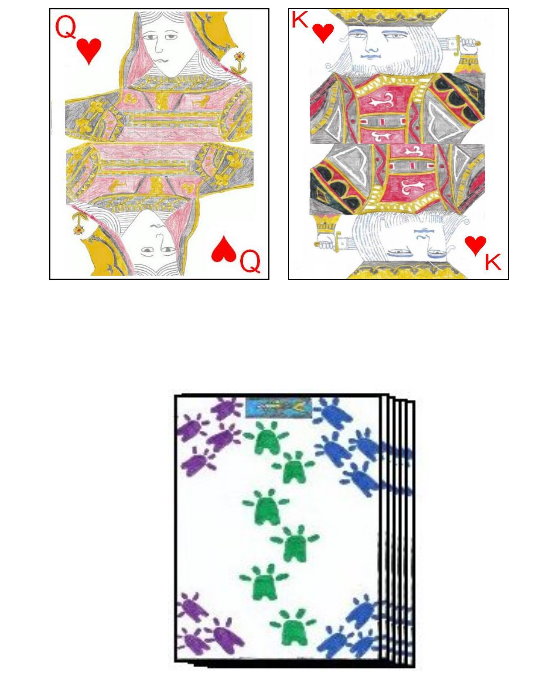 Royal Marriage
Royal Marriage: Royal Marriage is played similarly to standard Accordion. The differences are in the initial deal and the method by which the initial layout is compacted.
For the initial deal, the King and Queen of Hearts should be removed from the deck. Thus, the Queen is first dealt and then the remaining 50 cards in the deck and then lastly the King dealt at the very end of the line of cards.
Once this layout has been completed, the player may then begin play. In this variant, instead of combining cards, cards are simply removed from the layout and set aside. The rules for removal of cards from the layout are as follows:
- If any card in the layout has a card on either side of which both of those cards are of the same rank or the same suit, that middle card can be removed from the layout.
- If any two adjacent cards in the layout (regardless of rank or suit) are surrounded by two cards (one card to the right of the pair and another to the left) which are of the same suit or rank, those two middle cards can be removed from the layout.
As cards are removed from the layout, the cards to either side should be slid to close any gaps made from the removal of those cards. In order to be considered a win, the entire line must be removed save the King and Queen of Hearts, which would end up, with the removal of all the other cards, being the only remaining cards and adjacent. On average this game is won on approximately 19% of all deals.
Push Pin Solitaire: Push Pin Solitaire is played similarly to Royal Marriage. However, Push Pin uses two standard 52 card decks shuffled together. The player then begins dealing all 104 cards in one long line (which may need, by space constraints to be dealt as multiple rows).
After the entire deck is dealt out, the player may then begin removing cards from the layout as able and willing. The following are the legal plays in Push Pin Solitaire:
- If a card is surrounded on either side (to the left and right) by two other cards, with those cards being of the same suit or the same rank, that middle card can be removed, set aside out of play.
- If any two adjacent cards in the layout are surrounded (on the left and on the right) by two other cards, in which both of those surrounding cards are of the same suit or same rank, the two middle cards may be removed from the layout and set aside.
As cards are removed from the layout, the cards from the right should be pushed to close the gaps made in the line by card removal. The game is won if the all but two cards can be removed from the layout. The probability of a win in this solitaire game is approximately .05%.
Double Jump: Double Jump is another solitaire card game with rules based from Accordion Solitaire. Double Jump uses one standard 52 card deck to play.
To begin the player should thoroughly shuffle the deck and begin dealing out the entire 52 cards in the deck in one line. Due to space limitations, the actual line may need to span multiple rows, but the cards should be thought to be
in one continuous line.

Once all cards are dealt, the player should then examine the layout in an attempt to remove cards from the layout. Any two cards from the layout may be removed from that layout if they satisfy the condition that they are surrounded, on the right and left, of two other cards, in which those two other cards are of the same suit or same rank. Cards removed from the layout are set aside and out of play. As cards are removed from the layout, cards from the left should be slid to the right to compact the layout, filling in gaps formed by removal of cards from the line.
If a player manages to remove all but two cards from the original line layout, the player is said to have won the game. This game is said to have an approximate .04%
probability of winning on any specific deal.
French Solitaire: French Solitaire is another game similar to Double Jump. French Solitaire uses one standard deck consisting of 52 cards.
For the initial deal, the player should begin dealing all the cards from the deck, face-up in a single line. In order to conserve space, this line may actually span multiple rows, but the cards should be thought of logically as in one long line.
A card may be removed from the layout if that card is surrounded on the right and the left by two cards which are of the same rank or the same suit. Cards removed from the layout are set aside and out of play.
Dissimilar to most other similar games of this type, if the player has no more moves after his first initial deal, and there are more than two cards remaining in the initial layout, he may gather all the cards up still remaining in the layout, shuffle them together, and then deal these cards out again in another layout. He then begins again removing any cards from the layout, as per the rules given above.
If the player manages, after one or two deals to remove all but two cards from the line, that player said to have won the game. The winning probability in French Solitaire is approximately .5%.
Concertina Solitaire: Named after an ancient version of the Accordion as a musical instrument, Concertina Solitaire is also played very similarly to standard Accordion Solitaire. Concertina uses one standard 52 card deck.
To begin play, the dealer starts dealing the thoroughly shuffled deck in one long line of face-up cards. To conserve this line may actually be required to span multiple rows, but these rows should still be thought to comprise one long row of cards.
As in Accordion, the player examines the line of cards, searching for cards that can be removed from the layout. The following are the allowable moves in the game:
- If any card in the layout is spanned by two cards, to it's right and left, that are of the same suit or same rank, the two surrounding cards are removed, leaving the middle card intact.
- If any two adjacent cards in the layout are surrounded, on the right and left, by two other cards, in which those two cards are of the same rank or the same suit, those two surrounding cards may be removed from the layout.
All cards removed from the layout are set aside and no longer used in the current hand. As cards are removed from the layout, cards from the right should be pushed to the left to remove any gaps showing in the layout.
If the player manages to reduce the line down to just two remaining cards, the player is said to have won the game.
Cribbage Solitaire - Accordion: Bill Beers, traditionally famous for his Chess problems, created this form of solitaire which is a
mash up of Accordion Solitaire and Cribbage.
Cribbage Solitaire uses one standard 52 card deck and the player should also have handy a Cribbage board for recording his score during the hand. While possible to keep the ongoing score using pencil and paper, this is much more convenient using the Cribbage board.
The entire deck should be first be thoroughly shuffled by the player. The dealing method for Cribbage Solitaire is similar to the Compacted form as described above. In other words, the dealer should begin dealing out cards in one continuous row. As scoring combinations are revealed during the deal, the player should score for them. The following are possible scoring categories:
| Scoring Combination | Combination Description | Scoring Value | Example |
|---|
| One Pair | One pair of cards of the same rank which are directly adjacent to each other in the line. | 2 | 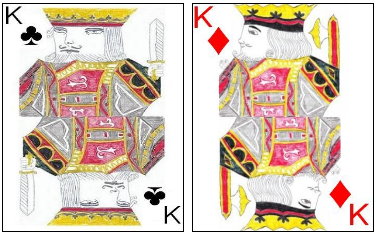 |
| Three of a Kind | Three cards all of the same rank, which are all directly adjacent to each other in the line. | 6 | 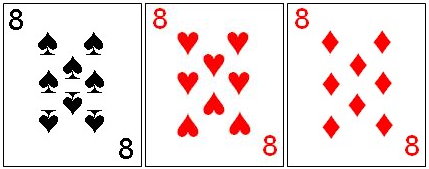 |
| Three cards, Same Suit | Three cards all of the same suit but not necessarily in numerical sequence. These three cards must all be directly adjacent in the line. | 3 | 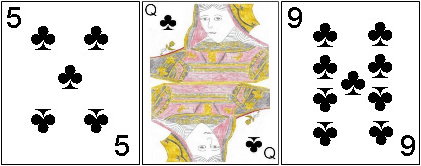 |
| Three cards in Sequence | Three cards, all adjacent to each other on the line, which are not necessarily all in the same suit, but which if combined, would produce a series of three cards in sequence. | 3 | 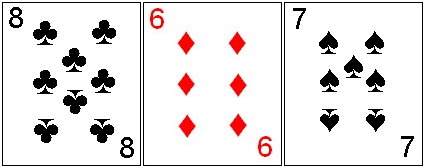 |
| Three card Straight Flush | Three cards, all adjacent to each other along the line, which are all of the same suit and which can be arranged to produce a series of three cards in sequential order. | 6 | 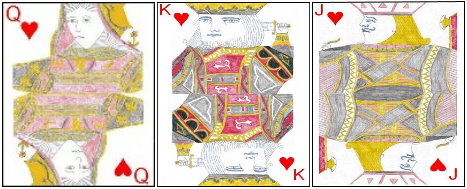 |
| Two card 15 | Two cards, directly adjacent to each other in the line, in which the ranks of those cards sum to exactly 15. | 2 | 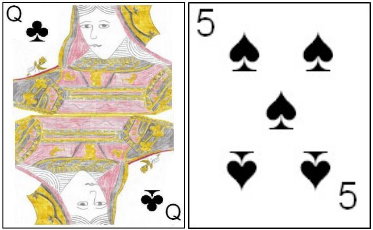 |
| Three card 15 | Three cards, all directly adjacent to each other along the line, in which the ranks of these three cards sum to exactly 15. | 2 | 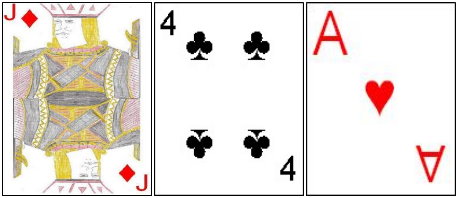 |
For purposes of calculating the sums of cards, each card has a specific summation value, as follows; Kings, Queens and Jacks have a 10 point value, Aces 1 point, and each other card the value as marked on that card. In addition, for purposes of the sequences used in the game, the cards are ranked in the deck for this game as follows (from high to low): King, Queen, Jack, 10, 9, 8, 7, 6, 5, 4, 3, 2, Ace.
Thus, as these combinations are exposed while dealing, the player may score for these combinations. If a player scores for One
Pair, he may not, however, score for Three of a kind
using those same cards. Thus, in dealing One Pair, the player should refrain from scoring the Pair until he deals the next card. If this next card makes a Three of a Kind, he may thus score for that combination, but if this does not create a Three of a Kind he may still opt to score for the Pair. Other than this exception, each combination must be scored immediately when it appears, or the opportunity is lost to score for the combination if further cards are dealt.
As soon as any combination is scored for, two of the cards in that combination are combined, placing one of those cards on top of the other. The player is free to select which card is put on top, but the player may not modify this once he makes his decision. If this change then creates a new scoring opportunity (either using existing cards already dealt) or additional cards as dealt in the line, the player may also score for these (and also combining cards as required by the rules).
If the player manages to score 61 or more points before the entire pack has been fully dealt, he is said to have won the game.
Copyright © 2015 CatsAtCards.com. All rights reserved.
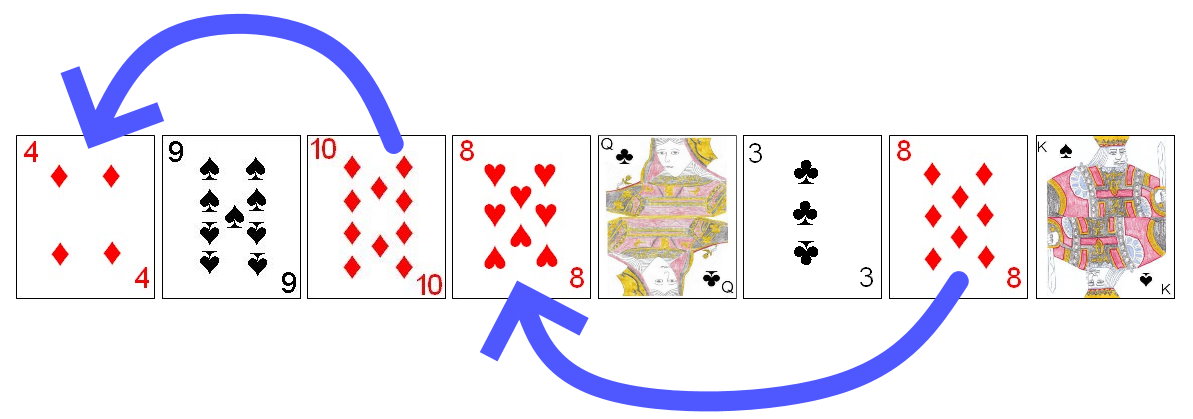

 Royal Marriage: Royal Marriage is played similarly to standard Accordion. The differences are in the initial deal and the method by which the initial layout is compacted.
Royal Marriage: Royal Marriage is played similarly to standard Accordion. The differences are in the initial deal and the method by which the initial layout is compacted.
 Once all cards are dealt, the player should then examine the layout in an attempt to remove cards from the layout. Any two cards from the layout may be removed from that layout if they satisfy the condition that they are surrounded, on the right and left, of two other cards, in which those two other cards are of the same suit or same rank. Cards removed from the layout are set aside and out of play. As cards are removed from the layout, cards from the left should be slid to the right to compact the layout, filling in gaps formed by removal of cards from the line.
Once all cards are dealt, the player should then examine the layout in an attempt to remove cards from the layout. Any two cards from the layout may be removed from that layout if they satisfy the condition that they are surrounded, on the right and left, of two other cards, in which those two other cards are of the same suit or same rank. Cards removed from the layout are set aside and out of play. As cards are removed from the layout, cards from the left should be slid to the right to compact the layout, filling in gaps formed by removal of cards from the line.






